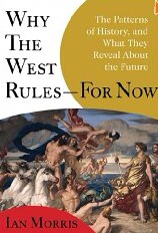I am almost done reading “Why the West rules – for now” by Ian Morris. It is simply one of the most impressive books I have read in my life.
The author starts by trying to answer the question “why did the west get to the industrial revolution first, and hence got to dominate the twentieth century ?”, but the book is not really about answering that question. Along the way Ian Morris analyses how civilisations grow, evolve and decline. It is a lot of learnings from the past, but also gives insights into our future – some of them quite scary 🙂
It is extremely well written, fun, entertaining, a real page turner. It’s a book you really enjoy reading, but which messages echo well after you have put it down.
Here are some of the learnings and questions I took away :
- All human have gone through the same stages of evolution, through social, economic and technological development.
- They also have all faced a ceiling, a limitation to their development inherent to their social and technological levels.
- And when they reach that ceiling, most often they don’t just plateau there, they also collapse and lose from their peak level. And some of these collapes are just not pretty to live through.
- Geography and climate have played a significant role in determining the pace of development and the fate of civilisations.
Now for the great and also the scary part : the “Social development index” that Ian Morris has measured from 14,000 BCE to today shows a huge steep increase in the past 100 years. One component of that index is the energy capture, ie how much energy we use to lead our lives, including the food we eat, animal muscle we leverage, or fossil fuels we burn. In prehistoric times this was at 4 kilocalories/person/day, and 14,000 years later during the Roman empire had gone up to 31. It then collapsed and only reached that level again in the west in 1700 CE (China had reached that level earlier in 1600). By 1800 it was still only at 38. But with the industrial revolution everything changed, and it had soared to 92 by 1900 (The eastern world by then had slipped behind and only reached 49), and further accelerated in the twentieth century to reach a whopping 230 (the east is on the same course and even though it is at “only” 104, its growth curve is rapidly catching up).
So we should feel priviledged to live in that “world of plenty” that is our era. It is not only unprecedented in terms of the civilization levels we have achieved, it has also seen a dramatic acceleration of wealth and possibilities in the last century, and does not give any signs of deceleration. It might also be the first time we have have a shot at building one global civilization, instead of the conflicting empires or nations of the past.
But we should also be scared that our civilization might hit a development ceiling like we always have before, and that we might have to live through a collapse in development level, with its accompanying unrest and destructions.
So how do we build new social models that will take us through that ceiling, and let continued technological developments keep carrying us forward ? Is climate change going to undo our progress at planetary level as it undid might empires in the past ? Will we really build that global civilization we have started to create, or will states, nations and empires prevail and be the main barriers to progress ?
History is the best way to put our humanity in perspective, and it gives us insights into who we are and the challenges lying ahead of us. This books provides a unique lens to think about our future, and to consider how technology and social models will shape our destiny – a must read !


